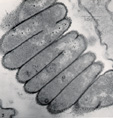 |
BIOL
230 MICROBIOLOGY LECTURE E-TEXT UNIT 6 |
MICROBIOLOGY LEARNING OBJECTS
UNIT 6
 |
BIOL
230 MICROBIOLOGY LECTURE E-TEXT UNIT 6 |
MICROBIOLOGY LEARNING OBJECTS
UNIT 6
ADAPTIVE IMMUNITY
TABLE OF CONTENTS
TOPICS
I. Introduction
A. Overview of Immunity; Antigens and Epitopes
B. Major Cells and Key Cell Surface Molecules Involved in Adaptive Immune Responses
2. Antigen-Presenting Cells (APCs)
D. An Overview of the Steps Involved in Adaptive Immune Responses
II. Humoral Immunity
A. Antibodies (Immunoglobulins)
1. An Overview
3. The 5 Classes (Isotypes) of Human Antibodies
4. Generation of Antibody Diversity
B. Ways That Antibodies Help to Defend the Body
1. Opsonization
2. Cytolysis by the Membrane Attack Complex (MAC)
3. Antibody-dependent Cellular Cytotoxicity (ADCC) by NK Cells
4. Neutralization of Exotoxins
6. Preventing Bacterial Adherence
7. Agglutination of Microorganisms
C. Naturally and Artificially Acquired Active and Passive Immunity
1. Naturally Acquired Immunity
III. Cell-Mediated Immunity
A. Cell-Mediated Immunity: An Overview
B. Ways That Cell-Mediated Immunity Help to Defend the Body
1. Activating Antigen-Specific Cytotoxic T- Lymphocytes (CTLs)
IV. Immunodeficiency
V. Hypersensitivities
B. Immediate Hypersensitivities
Gary E. Kaiser, Ph.D.
Professor of Microbiology
The Community College of Baltimore County, Catonsville Campus
This work is licensed under a Creative Commons Attribution 4.0 International License.
Based on a work The Grapes of Staph at https://cwoer.ccbcmd.edu/science/microbiology/index_gos.html.
Last updated: August, 2021
Please send comments and inquiries to Dr.
Gary Kaiser